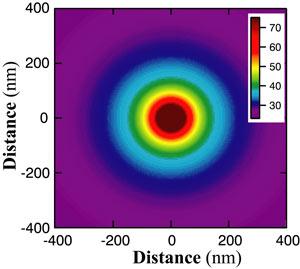Life can be challenging on the biophysics research frontier. Consider gold nanoparticles as a research tool, for example. Gold is ductile and malleable as well as being a good conductor of heat and electricity. Its unique chemistry allows proteins and DNA to be easily attached to these nanoparticles. Physicists have been investigating gold nanoparticles in optical-trapping experiments because they enhance trapping efficiency and potentially increase detection sensitivity. Medical scientists have targeted cancer cells in tumors with gold nanoparticles and then illuminated the tumors with fiber-optic lasers. The gold nanoparticles absorb the light, heat up, and destroy the tumor. In the field of biophysics, one has to consider both issues, heating and enhanced optical trapping.
Research Associate Yeonee Seol, Graduate Student Amanda Carpenter, and Fellow Tom Perkins routinely perform precision optical-trapping experiments on molecular motors and DNA-binding proteins. As physicists, Seol and her colleagues were intrigued by the promise of gold nanoparticles being able to significantly boost the trapping efficiency and detection sensitivity of their optical-trapping assays. As biologists, however, they were worried whether laser-induced heating of gold nanoparticles could deactivate the proteins under study, compromising their results.
The researchers decided to perform their own experiments to compare gold nanoparticles with polystyrene beads. What they discovered was that the trapping efficiency and detection sensitivity of experiments using large gold nanoparticles were six times higher than those using polystyrene beads of comparable size. In experiments using low laser powers (=100 μW), the gold beads cause temperature increases of less than 1°C. Thus, small gold nanoparticles make an excellent choice for enhancing signal detection in biophysical assays where they are used to tether biological molecules of interest. Additionally, because they are small, they make room for larger DNA or other biomolecules within what is often a limited detection range.
Unfortunately, the most common trapping wavelength of infrared light (1064 nm) induced dramatic heating of the gold beads - equal to 266°C per watt of laser power. The temperature gradient (in °C) around one gold bead is shown at right. Near the gold beads, temperatures are high enough to denature most biological molecules.
"We verified gold's good properties but showed that gold beads are a disaster for standard biological assays using laser trapping," Seol said. On the other hand, the heating induced by laser light means that small gold beads could be used as local molecular heaters to vary the temperature for single-molecule enzyme assays, something that has been traditionally very difficult to do. In addition, the local temperature can be increased by tens of °C in a few nanoseconds. This new found ability will allow Seol and her colleagues to almost instantaneously jump the temperature of a single molecule of RNA or protein and watch it thermally unfold. - Julie Phillips




